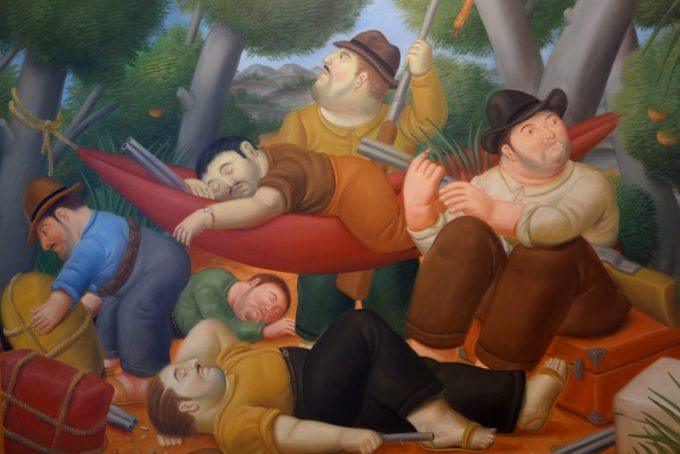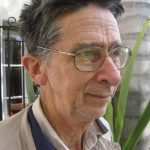Court Cases Show Colombian Government Role in Paramilitary Killings, US Implicated


Orinoco Tribune – News and opinion pieces about Venezuela and beyond
From Venezuela and made by Venezuelan Chavistas

By W. T. Whitney – Nov 18, 2021
Struggle over agrarian rights in Colombia led to thousands of deaths after 1946. Then, 200,000 more were killed between 1948 and 1958. From then until 2018, class war involving leftist guerrillas, narcotraffickers, paramilitaries, big landholders, and Colombia’s Army took the lives of another 260,000 Colombians.
The 2016 agreement ending 50 years of armed conflict between the Revolutionary Armed Forces of Colombia (FARC) and Colombia’s government might have brought peace. Since the accord was signed, however, killers, presumably paramilitaries, have taken the lives of 292 former FARC combatants and 1241“social leaders.”
Special Forces General William Yarborough, reporting on a U.S advisory mission to Colombia in 1962, recommended “a civil and military structure … [that could] execute paramilitary, sabotage and/or terrorist activities against known communist proponents.” Even so, paramilitary activities remained quiescent until the 1980s. From then on, paramilitary assaults multiplied in rural areas, leaving deaths, destitution and displacement in their wake.
Revived counter-insurgency leanings and the perennial anti-communism of Colombia’s elite, including the military, were contributing factors. Narcotraffickers and local landholders, seeking wealth and also protection from leftist guerrillas, cooperated in forming new paramilitary units. Violent incidents have mounted since, media reports attributing them to “unknown assailants” or the like. Colombian and U.S. political leaders generally ignore them.
Now two court cases cast new light on Colombia’s paramilitary problem, as does a prominent leftist political figure’s commentary on the capture of a high-profile narco-trafficker. The Colombian government’s role in sustaining the paramilitaries is becoming clear. And what looks like a facilitating role of the United States begs the question of U.S. accountability.
RELATED CONTENT: Washington’s Interventionist Agenda: New SOUTHCOM Head Arrives in Colombia
She knows
Piedad Cordoba took the arrest on October 23 of “Colombia’s most wanted drug trafficker” as an opportunity to explore the linkage of drug-trafficking and paramilitarism. Dairo Antonio Usuga, known as Otoniel, headed the Gulf Clan, which exports cocaine to the United States. The U.S. government offered $5 million for his capture.
Cordoba refers to the “counterinsurgent essence” of the Gulf Clan, which is a “de facto agent of the state.” It participates in that “great capitalist and transnational business of narcotics.” But, “one can’t deny that they are paramilitaries. They’ve been directly involved in the war against communities and social movements.”
Cordoba denounces her government’s practice of extraditing narco-traffickers and paramilitaries to the United States. She condemns the “profitable business of the [U.S.] DEA in removing the head narco-traffickers only to have them automatically replaced, with the criminal structures intact.” The process “contributes to perpetuating the narco-paramilitary phenomenon.”
The peace agreement between Colombia’s government and the FARC established a Special Jurisdiction for Peace (JEP) to establish the truth about the crimes and victims associated with the civil war. The object was to secure “justice, reparations, and no repetition.” Piedad Cordoba wants the JEP to incorporate the Otoniel case into its “new process being opened up concerning the relationship between the paramilitaries and the nation’s military and police.”
Piedad Cordoba wants the JEP to incorporate the Otoniel case into its “new process being opened up concerning the relationship between the paramilitaries and the nation’s military and police.”
The JEP, she hopes, will document paramilitary crimes that extend beyond narco-trafficking and “narco-terrorism,” specifically murders, disappearances, and torture. She wants the JEP to show that Colombia’s military, police, and intelligent services facilitated these crimes.
In court, in Florida
A ruling issued by a U.S. court on September 27 points to a broad range of paramilitary crimes. Judge Edwin Torres of Florida’s Southern District found paramilitary chieftain Carlos Mario Jiménez, alias Macaco, to be responsible for extrajudicial killings and torture in Colombia. Relying on declassified intelligence documents provided by the National Security Agency, the judge implicated Colombian state agencies.
The plaintiffs in the case, which began in 2010, were family members of Eduardo Estrada Gutiérrez. Paramilitaries constituting the Central Bolivar Bloc, commanded by Carlos Mario Jiménez, killed this Colombian community leader and journalist in 2001. Jiménez, now incarcerated in Colombia, must pay the family $12 million.
Jiménez’s story is representative of paramilitary leaders extradited to the United States by the Colombian government during Alvaro Uribe’s presidency (2002-2010). As with all 600 prisoners extradited there by the Uribe government through 2008, these paramilitaries would be prosecuted exclusively on drug-trafficking charges.
Jiménez’s extradition took place on May 7, 2008; 14 other high-level paramilitaries followed a few days later. Found guilty, they would serve light sentences in the United States, as prescribed by Uribe’s pre-existing program for demobilizing paramilitaries. Jiménez received a 33-year sentence, because he had violated terms of that program. U.S. authorities returned him to Colombia in 2019 to serve the remainder of his sentence there.
Claiming paramilitaries would escape punishment for serious crimes, critics in Colombia and worldwideprotested their extradition. Their complaints found little resonance among officials of a Colombian government that itself enjoyed scandalous ties with paramilitaries.
The National Security Archive indicates on its website that, “In ruling for the plaintiffs, Torres cited ‘an abundance of evidence’ that the BCB “operated in a symbiotic relationship with Colombian state actors.’” The Archive provided prosecutors with summaries of 10 declassified documents from U.S. intelligence sources.
Judger Torres’s decision lends credence to accusations that Colombia’s government worked in tandem with paramilitaries. U.S. complicity is suggested. After all, the U.S. government still provides military support to a Colombian government that is associated with criminally-inclined paramilitaries. Having prosecuted the extradited paramilitary chieftains on a lesser offense, it assisted in a Colombian government cover-up.
In court, in Colombia
A judicial proceeding in Colombia on October 21 likewise sheds light on who controls the paramilitaries. The JEP is considering the case of Andrés Mario Espinosa Garcés as it looks into the origins of massacres after 1985 of members of the Patriotic Union electoral coalition (UP as per Spanish initials).
At the time, the UP consisted of demobilized FARC combatants, Communist Party members and other leftists, of whom over 4000 were eventually killed. The JEP’s presiding judge affirmed that “a systematic pattern of extermination … existed against members of the Patriotic Union.”
The testimony of Espinosa Garces before the JEP reflected the contents of a report he had earlier delivered to the Supreme Court for Justice. That court was considering charges of homicide and criminal conspiracy against retired police general Miguel Alfredo Maza Márquez, who was Espinosa Garcés’s superior officer. The latter was then serving as a criminal investigator for Colombia’s DAS intelligence agency.
In that capacity Espinosa Garcés interviewed military personnel and others, thereby accumulating information that contributed to his written and verbal testimony. He told the JEP’s presiding officer that paramilitaries coordinated lethal operations with Colombia’s military, also that paramilitaries did most of the killing of UP members, and killed unionists and students as well. He elaborated upon “the relationship of paramilitaries with the national army.”
RELATED CONTENT: Seven Individuals with Ties to Colombian Paramilitary Gangs Captured in Venezuela
Espinosa Garcés provided circumstantial evidence of U.S. government involvement in the UP massacre. He “signed orders to monitor, profile and follow members of the Patriotic Union including their families.” The U.S. government is implicated, because Espinosa Garcés was a U.S. agent. Media reports describe him as a “criminal investigator for the FBI” and as an “intelligence analyst for the Department of State.” His name appears as a graduate of the FBI National Academy.
Both Piedad Cordoba’s commentary and information from these two sets of court proceedings are relevant to how the U.S. government deals with military allies. The Leahy Law supposedly prohibits the U. S. government from providing military aid to a country that abuses human rights.
There are two Leahy laws. One, in force since 1961, applies to the State Department. The other, dating from 1991, requires that the Defense Department not use funds “for any training, equipment, or other assistance for a foreign security force unit if the Secretary of Defense has credible information that such unit has committed a GVHR” (gross violations of human rights).
The U.S government for decades has provided its Colombian ally with ample personnel, money, equipment, and intelligence capabilities. An opportunity waits. U.S. critics of their country’s intervention in Colombia must call the U.S. government to account. Doing so with petitions, open letters, lobbying, and more would be consciousness-raising, and a prelude to a new U.S.-based campaign for justice in Colombia.
Featured image: Painting of Eliseo Velásquez leading guerrilla forces. Fernando Botero “Guerrilla de Eliseo Velásquez” – Public Domain

W.T. Whitney Jr. grew up on a dairy farm in Vermont and now lives in rural Maine. He practiced and taught pediatrics for 35 years and long ago joined the Cuba solidarity movement, working with Let Cuba Live of Maine, Pastors for Peace, and the Venceremos Brigade. He writes on Latin America and health issues for the People's World.
Support Groundbreaking Anti-Imperialist Journalism: Stand with Orinoco Tribune!
For 7 years, we’ve delivered unwavering truth from the Global South frontline – no corporate filters, no hidden agenda.
Last year’s impact:
• Almost 200K active readers demanding bold perspectives
• 216 original pieces published in 2025 alone
Fuel our truth-telling: Every contribution strengthens independent media that actually challenges imperialism.
Be the difference: Donate now to keep radical journalism alive!